Pitcairn Islands 2009 "Bicentenary of the birth of Charles Darwin"
| <prev | back to index | next> |
| Issue Date | 24.06.2009 |
| ID | Michel: 779-782; Scott: 686-689, Stanley Gibbons: 784-787; Yvert et Tellier: 715-718; Category: Dw |
| Design | Jennifer Toombs, Suffolk, United Kingdom Stamps and FDC photography and signature courtesy of Natural History Museum, UK |
| Stamps in set | 4 |
| Value |
50c. - Charles Darwin with HMS Beagle and Toxodon skull $1.50 - Charles Darwin with Galapagos giant tortoise (Chelonoidis nigra) and marine iguana (Amblyrhynchus cristatus) $2.00 - Charles Darwin with Darwin's finches (Camarhynchus sp.) $3.50- Charles Darwin with "Origin of Species" and gorilla (Gorilla gorilla) |
| Emission/Type | commemorative |
| Issue place | Adamstown |
| Size (width x height) | 36.9 mm x 37.5 mm |
| Layout | Sheets of 30 stamps: 2 panes of 15 stamps with a central gutter |
| Products | FDC x1 |
| Paper | 104gsm Tullis Russell non phosphor gummed paper |
| Perforation | 14.4 x 14.6 |
| Print Technique | Offset lithography |
| Printed by | Southern Colour Print, Dunedin, New Zealand |
| Quantity | |
| Issuing Authority | Pitcairn Islands Post |
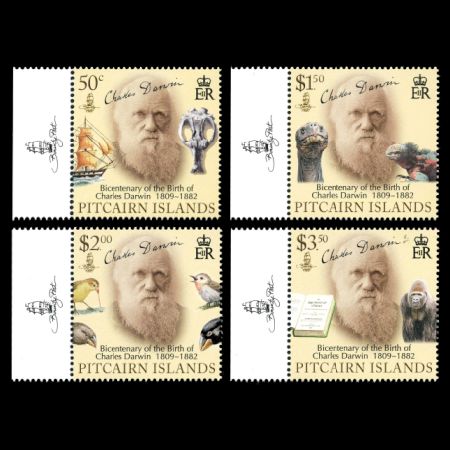
On June 24th, 2009, the Post Authority of Pitcairn Islands issued the set of four stamps "Bicentenary of the birth of Charles Darwin". These stamps were printed in Sheets of 30 stamps: 2 panes of 15 stamps with a central gutter showing the HMS Beagle.
The following text is a quote from the press release published by Postal Bureau of Pitcairn Islands in 2009 with additional text about the Toxodon skull added by the author of this website.
2009 is both the 200th Anniversary or bicentenary of the birth of the greatest naturalist in history, Charles Robert Darwin (1809-1882), and the 150th Anniversary of the publication of his most famous work "On the Origin of Species by Means of Natural Selection".
Born in Shrewsbury, Darwin studied at Edinburgh University and Christs College, Cambridge, before embarking at the age of 22 on a five-year journey to South America, the Galapagos Islands and beyond, aboard the HMS Beagle.
At this time, most Europeans believed that the world was created by God in seven days as described in the Bible. On the voyage Darwin read Lyell's "Principles of Geology" which suggested that the fossils found in rocks were actually evidence of animals that had lived thousands or even millions of years ago. The animal life and geological features that he saw on the voyage reinforced Lyell's argument and Darwin linked the fossils to modern species.
Upon his return to England, Darwin conducted thorough research of his notes and specimens and out of this long study grew several related theories:
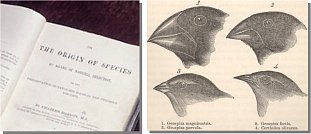
- Evolution did occur
- Evolutionary change was gradual, requiring millions of years
- The primary mechanism for evolution was a process called natural selection
- The millions of species alive today arose from a single original life form evolving through a branching process called speciation
Darwin's theory of evolutionary selection holds that variation within species occurs randomly and that the survival or extinction of each organism is determined by that organisms ability to adapt to its environment. This theory of evolution by natural selection underlies all modern biology.
At times controversial, the theory remains unchallenged as the central concept of biology and it profoundly altered our view of the natural world and our place in it.
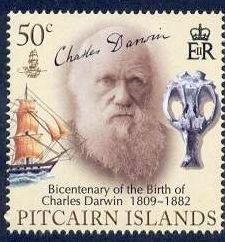 |
| Charles Darwin with Toxodon skull on stamps of Pitcairn islands 2009, MiNr.: , Scott: |
 |
| Toxodon stamp of Uruguay 1996, MiNr.: , Scott: |
Toxodon, meaning "bow tooth" in reference to the curvature of the teeth, is an extinct genus of South American mammal from the Late Miocene to early Holocene epochs who lived from 11.6 million to 11,000 years ago.
Toxodon was described in 1837 by Richard Owen based on remains collected by Darwin.
Toxodon was about 2.7 meters in body length, with an estimated weight up to 1,415 kg and about 1.5 meter high at the shoulder and resembled a heavy rhinoceros, with a short and vaguely hippopotamus-like head.
Evidence suggests that Toxodon was ecologically plastic and able to adapt its diet to local conditions.
Charles Darwin was one of the first to collect Toxodon fossils, after paying 18 pence for a Toxodon platensis skull from a farmer in Uruguay, during his visit to the country on the voyage of the HMS Beagle.
This skull was one of the many spectacular fossils Darwin sent home from South America. Some boys in a remote village in Uruguay had used the skull for target practice and knocked a tooth out with a stone.
In "The Voyage of the Beagle" Darwin wrote,
"November 26th – I set out on my return in a direct line for Montevideo. Having heard of some giant's bones at a neighbouring farm-house on the Sarandis, a small stream entering the Rio Negro, I rode there accompanied by my host and purchased for the value of eighteen pence the head of the Toxodon."
Since Darwin discovered that the fossils of similar mammals of South America were different from those in Europe, he invoked many debates about the evolution and natural selection of animals.Paleontologist Richard Owen analyzed the fossil mammals from the Beagle voyage. This life-sized lithograph of the Toxodon skull by artist George Scharf was part of the Zoology of the Voyage of H.M.S. Beagle, edited by Darwin.
Products
| FDC | First-Day-of-Issue Postmark | Gutter pairs |
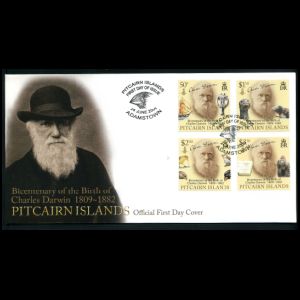 |
 |
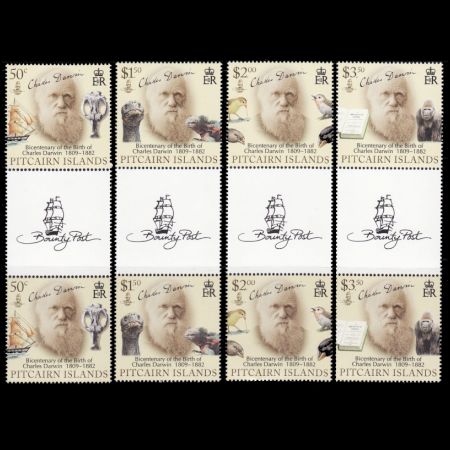 |
Some books of and about Charles Darwin
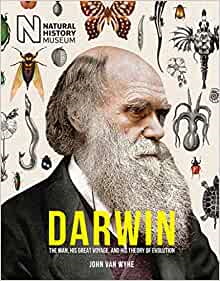
|
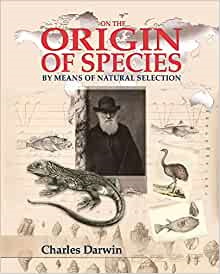
|
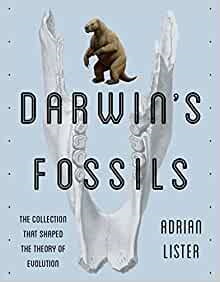
|
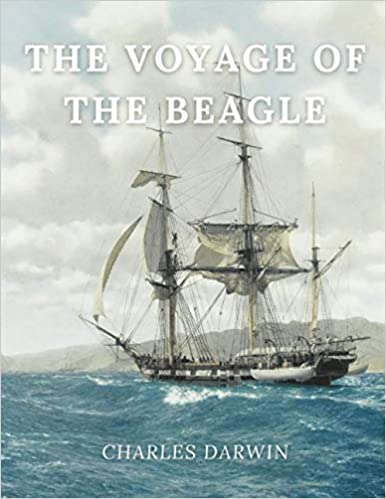
|
|
"Darwin: The Man, his great voyage, and his Theory of Evolution", by John Van Wyhe. Published in 2018. Amazon: USA, UK, DE Free PDF files from Darwin-online website: "Charles Darwin: his life and work by Charles Frederick Holder, published in 1892" |
"On the Origin of Species: By Means of Natural Selection: Slip-Cased Edition" Amazon: USA, UK, DE Free PDF files from Darwin-online website. |
"Darwin's Fossils: The Collection That Shaped the Theory of Evolution", by Adrian Lister. Published in 2018. Amazon: USA, UK, DE |
"The Voyage of the Beagle" Amazon: USA, UK, DE Free PDF files from Darwin-online website. |

|
References
- Technical details: Philatelic Bureau of Pitcairn Islands Post colnect
- Toxodon: Wikipedia, National Geographic,
Acknowledgements
Many thanks to Dr. Peter Voice from Department of Geological and Environmental Sciences, Western Michigan University, for reviewing the draft page and his very valuable comments.| <prev | back to index | next> |